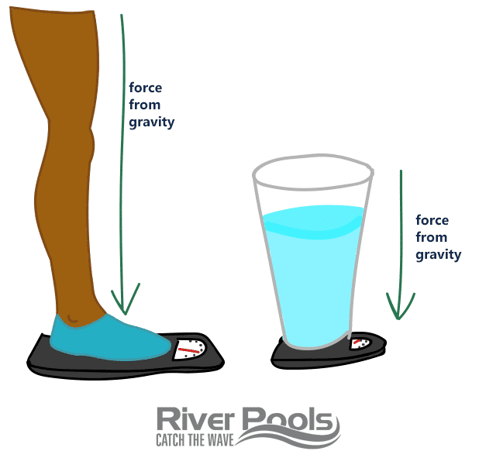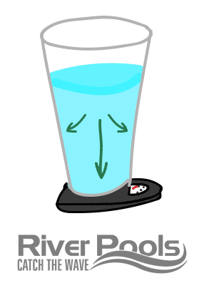Odds are, you’ve heard pool people tell you, frantically and with tears in their eyes, “Don’t drain your inground pool!” They mention hydrostatic pressure as the reasoning before running off to warn the next pool owner they can find. It’s nice of them to alert you…but what are they talking about? Why shouldn’t you drain your pool, really? What does “hydrostatic” even mean?
Not to worry, friend. I have your back.
Let’s talk pool physics.
Science Corner: Hydrostatic Pressure
So what is hydrostatic pressure, anyway?
The dictionary definition: “The pressure exerted by a fluid at equilibrium at a given point within the fluid, due to the force of gravity. Hydrostatic pressure increases in proportion to depth measured from the surface because of the increasing weight of fluid exerting downward force from above.”
Thanks, dictionary. That’s completely useless to me.
At the most basic level, hydrostatic pressure is how hard the water is shoving at the walls of its container.
This only applies to water that’s hanging out in one place, not in motion. Hence “hydro” (water) + “static” (at rest).
Want to know more? You’re in luck. Time for the least scientific-sounding explanation ever.
Weight = Pressure
All right, so when you weigh yourself on a scale, it’s not measuring your mass, but your pressure on the scale. Your weight is your downward pressure, thanks to gravity.
Now imagine a glass of water sitting on that scale.

The weight of the glass of water is, again, the downward pressure. But brace yourself: that’s not the only pressure it’s giving off.
Water, like your local teenager, wants to be free and will push against all boundaries to achieve that.
“Let me out,” says the water. “I want to go to Jessica’s party. You don’t understand me.”

Instead of getting a tattoo or climbing out a bedroom window, the water rebels by shoving against every “wall” in its container to try to break out of prison.
So now you have all-around pressure. Hydrostatic pressure.
Boom.
Buoyant Force
Let’s say that, in a fit of pique, you throw a chunk of wood into a puddle. It ends up lying on the ground.
However, if you throw that same chunk of wood into the ocean, it floats. (Also, you should look into anger management.)
So what’s the difference?
Buoyant force, or buoyancy, is the upward force of water that counters gravity. It’s a type of hydrostatic pressure.
The water will push away anything it can, but there are Rules.
Sinking means that buoyancy < weight.
Floating means that buoyancy > weight.
(So why do ships float? The steel of a ship is denser than water, but it encloses a bunch of air, and all that together has less average density than the ocean.)
When an object doesn’t move, that means the buoyancy equals the weight of the object.
Two Water Pressures at War
Now we’re bringing it all together. (I hope you were paying attention!)
How do different types of water pressure affect an inground pool?
For starters, you have hydrostatic pressure from inside the pool and buoyant force (also hydrostatic pressure) from outside the pool.
When you drop a pool into the ground and fill it with water (in the case of fiberglass pools), you create internal water pressure. The water inside the pool starts pushing against the sides and bottom of the pool shell to be free. Hydrostatic pressure.
You drain out the groundwater to put the pool in, but that rascally groundwater can still come back.
The hole holding your pool is no different from any other hole in your yard. It fills with water. Rain? Snow? A lot of crying in the backyard? Hello, water under and around the pool.
This saturates the soil. Your type of soil will determine how long water remains in the cavity outside your pool. Sandy soil is most permeable; clay is least.
That surrounding water wants the pool to go away, so it pushes up against it. Buoyant force, aka upward hydrostatic pressure.
If the pool is full of water, it’s heavy enough to counteract the upward pressure of the groundwater, and it won’t move.
The problem comes when you drain the pool. Even lowering the water level below the skimmer can be enough to ruin your life (well, your pool’s life).
Without the weight of all the water, the pool loses downward pressure. Buoyancy takes advantage of this. That pressure shoves upward as fast as it can. “Go away, pool.”
When there’s insufficient water in the pool, the shell can bulge, crack, or even float. Not ideal.
How to Keep Your Pool from Floating
First and foremost, your pool needs a dewatering system so that you can inspect and remove groundwater if necessary. It’s a proactive solution.
Second, and just as important: Do not drain your pool. Don’t do it! If you feel it absolutely requires draining, hire an authorized professional to do it. This would ensure your warranty stays intact.
These principles apply to all types of pools. With enough uplift from water pressure, concrete pools will actually float. Vinyl liners bubble and float inside the pool as well.
Fiberglass pools can pop up, too. However, after years of being in the fiberglass pool industry, it's not a common occurance we have seen.
Want more info about pools?
If you’re into this absurdly casual approach to pool science, you should check out our explanation of pool chlorine. It’s pretty fun, if I do say so myself.
If you’d like to learn more about the different types of pools, check out our comprehensive ebook "Comparing Fiberglass, Concrete, and Vinyl Liner Pools in the Modern Age.” It discusses cost, design, surface durability, installation… basically any aspect you’ll want to compare if you make a big pool decision.

Up Next:
Fiberglass Swimming Pools 101: Manufacturing, Cost, and More
Should You Buy a Fiberglass Pool? (Infographic)
What Is a Semi Inground Pool? A Review of Cost, Problems, and More
Editor's note: This article was updated on December 12, 2023.




